OR/14/043 Site description - Mc Walters Dingle
| Farr, G, Graham, J, and Stratford, C. 2014. Survey, characterisation and condition assessment of Palustriella dominated springs 'H7220 Petrifying springs with tufa formation (Cratoneurion)' in Wales. British Geological Survey Internal Report, OR/14/043. |
Introduction
Mc Walters’ Dingle is located in a wooded section of the Afon y Garth gorge and there are two sections of tufa. Only the main block of tufa was included in any detail within this survey although notes are made on the second smaller site. Chris Twigg, Stewart Campbell (NRW) and Dr Jackie Maplas (NE Wales RIGS) also accompanied us on the site visit.
Geological and hydrogeological data
Mc Walters Dingle is located within a north east–south west trending gorge along which several small tributaries flow, feeding the Afon y Garth that flows north east into the Dee Estuary. The tributaries are sourced in the Lower Carboniferous Pentre Chert and Bowland Shale Formation to the west. In the area of the main tufa block deposit the gorge cuts through the Carboniferous Pennine Lower Coal Measures and further down the gorge into the Gwespyr Sandstone. Glacial till is mapped across the majority of area outside of the gorge masking the majority of the surface exposure, however it can be seen in Nant-Felyn-blym (Howard, et al 2007[1]) which joins the Afon y Garth about 1 km downstream of the tufa deposit. Localised deposits of head are mapped following the trend of the gorge. The tufa block at Mc Walters Dingle has been surveyed by Mr C Twigg and the survey diagram is presented within this chapter.
The principal tufa block is located on the northern side of the Afon y Garth and has been surveyed by Mr C Twigg. The survey suggests that the tufa block is at least 27 m in length, starting at the break of slope on the northern side of the gorge and terminating in a steep face when it meets the Afon y Garth.
The tufa block is situated within a wooded section of the gorge and is covered in leaf litter. The most northern part of the tufa, coincident with the break in slope is very wet and water can be seen issuing across this margin. The water discharges from the break in slope and flows across the tufa block towards the stream via runnels and across the surface of the deposit. The seepage water at the break in slope had a pH of 7.66 and EC of 895uscm. Water discharges across the face of the tufa block where it meets the Afon y Garth with values of pH 7.83 and 886μs/cm were recorded. A full sample was obtained from the outflow point of the tufa block by collecting seepage water that had passed over or through the tufa block. The results show that the water is hard and dominated by Calcium (136 mg/l) and Bicarbonate (404 mg/l) ions but also has significant quantities of Sulphate (65 mg/l) and Chloride (60.2 mg/l). Phosphate and orthophosphate are both below their respective limits of detection, there is however 2.9 mg/l Nitrate–N.

Land use and pressures
The dingle can be used by walkers although the footfall is presumed to be low in the area of the survey site. It does not appear that there are any grazing animals and poaching is not considered to be a known pressure. There is no evidence of burning. There is old infrastructure for the pumping of water within the base of the dingle associated with past industry. However none of the infrastructure appears to be working or in use and thus is not considered to be a pressure.
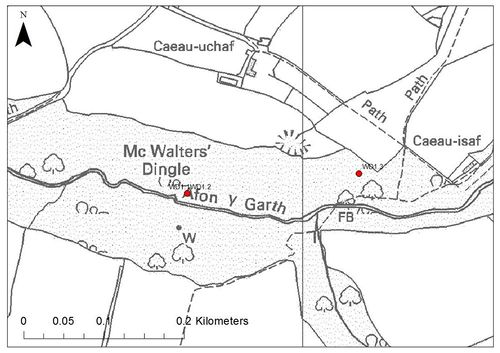
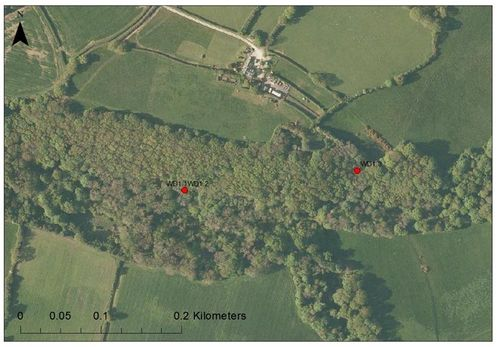
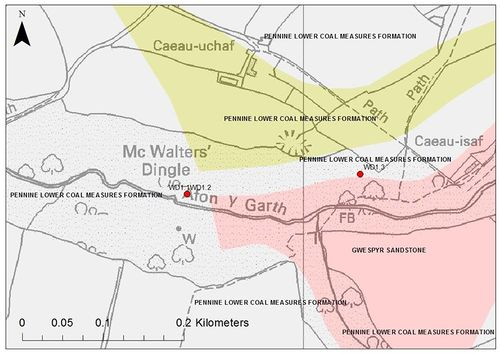
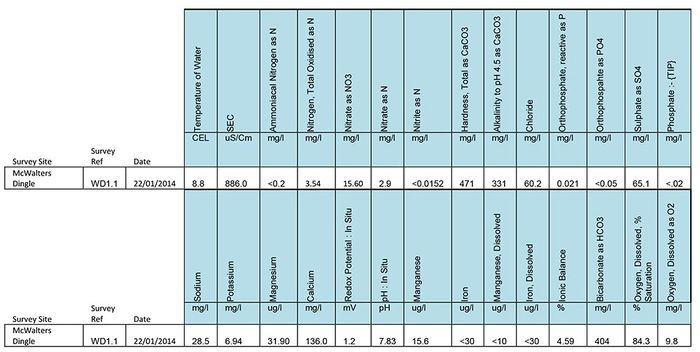
Vegetation (spring) for Mc Walters Dingle Site 1
Seepages with substantial tufa deposits dominated by Palustriella commutata beside a stream in a wooded gorge. A small number of other species include Pellia endiviifolia, Conocephalum conicum and Crataneron filicinum. There is deep leaf litter (with tussocks of Palustriella commutata proliferating in gaps between the leaf litter) and where water seeps through surface clay (in the absence of significant tufa), Filipendula ulmaria and Deschampsia cespitosa are rather more unusual associates.
| Chrysosplenium oppositifolium | R |
| Conocephalum conicum | O |
| Cratoneuron filicinum | O |
| Deschampsia cespitosa | O |
| Filipendula ulmaria | O |
| Palustriella commutata | D |
| Pellia endiviifolia | R |
| Plagiomnium undulatum | R |
| Leaf litter (from previous season) | F |
Rocks with substantial formations of tufa at the margins of a stream within a woodland gorge. These rocky/tufa areas generally are not so strongly flushed by adjoining springs, lack Palustriella and are dominated by a small number of species including Asplenium scolopendrium, Conocephalum conicum, Fissidens taxifolius var. taxifolius, Pellia endiviifolia, Hedera helix, Geranium robertianum, Tortella tortuosa and locally Fissidens gracilifolius.
| Asplenium scolopendrium | F |
| Bryoerythrophyllum recurvirostrum | O |
| Conocephalum conicum | F |
| Didymodon spadaceus | R |
| Fissidens taxifolius var. taxifolius | F |
| Fissidens gracilifolius (spor.) | O |
| Geranium robertianum | R |
| Hedera helix | O |
| Pellia endiivifolia | O |
| Rhynchostegium riparioides | R |
| Thamnobryum alopecurum | O |
| Tortella tortuosa | R |
A small number of common bryophytes on tree bases (within area of flush/spring but above the level of seepage water).
| Isothecium myosuroides | A |
| Kindbergia praelonga | O |
| Lophocolea bidentata | R |
A small number of common (mainly calcifuge) ferns and bryophytes on rotting logs and tree stumps (within area of flush/spring but above level the of seepage water).
| Dryopteris dilatata | R |
| Kindbergia praelonga | F |
| Mnium hornum | A |
| Plagiomnium undulatum | R |
| Plagiothecium succulentum (spor.) | F |
| Rhizomnium punctatum | R |
Vegetation (adjoining spring) for Mc Walters dingle Site 1
Spring line within mature woodland dominated by Equisetum arvense with occasional Carex pendula.
| Equisetum arvense | A |
| Carex pendula | O |
Ancient Ash–Hazel dominated woodland with a rich ground flora including Mercurialis perennis, Ficaria verna, Galium odoratum, Geum urbanum, Oxalis acetosa, Viola riviniana, Fissidens taxifolius var. taxifolius, Thamnobryum alopecurum.
| Asplenium scolopendrium | F |
| Brachypodium sylvaticum | O |
| Cardamine flexuosa | R |
| Carex sylvatica | R |
| Corylus avellana | O |
| Dryopteris felix-mass | R |
| Eurhynchium striatum | F |
| Ficaria verna | R |
| Fissidena taxifolius var. taxifolius | R |
| Fraxinus excelsior | F |
| Galium odoratum | R |
| Geum urbanum | O |
| Hedera helix | F |
| Ilex aquifolium | R |
| Mercurialis perennis | R |
| Oxalis acetosa | R |
| Oxyrrhynchium hians | O |
| Plagiochila asplenioides | R |
| Plagiomnium undulatum | O |
| Ranunculus repens | R |
| Rubus fruticosus agg. | O |
| Thamnobryum alopecurum | O |
| Viola riviniana | R |
Vegetation (spring) for Mc Walters Dingle Site 2
A small area (c. 3 x 2 m) with frequent Palustriella commutata where Seepages with tufa adjoin the margin of a stream in a wooded gorge. A small number of other species include Pellia endiviifolia, Conocephalum conicum, Cratoneuron filicinum and locally Chrysosplenium oppositifolium and Deschampsia cespitosa.
| Chrysosplenium oppositifolium | R |
| Conocephalum conicum | O |
| Cratoneuron filicinum | O |
| Deschampsia cespitosa | R |
| Palustriella commutata | F |
| Pellia endiviifolia | R |
Rocks with substantial formations of tufa at the margins of a stream within a woodland gorge. These rocky/tufa areas generally are not so strongly flushed by adjoining springs, lack Palustriella and are dominated by a small number of species including Asplenium scolopendrium, Bryoerythrophyllum recurvirostrum, Conocephalum conicum, Fissidens taxifolius var. taxifolius, Pellia endiviifolia, Hedera helix, Geranium robertianum and Thanmnobryum alopecurum.
| Asplenium scolopendrium | F |
| Bryoerythrophyllum recurvirostrum | O |
| Conocephalum conicum | F |
| Fissidens taxifolius var. taxifolius | F |
| Fissidens gracilifolius (spor.) | O |
| Geranium robertianum | R |
| Hedera helix | O |
| Pellia endiviifolia | O |
| Thamnobryum alopecurum | R |
Vegetation (adjoining spring) for Mc Walters Dingle Site 2
Ancient Ash–Hazel dominated woodland with a rich ground flora including Mercurialis perennis, Ficaria verna, Galium odoratum, Geum urbanum, Oxalis acetosa, Carex pendula, Cardamine flexuosa, Fissidens taxifolius var. taxifolius and Thamnobryum alopecurum.
| Asplenium scolopendrium | F |
| Brachypodium sylvaticum | O |
| Cardamine flexuosa | R |
| Corylus avellana | O |
| Dryopteris felix-mass | R |
| Eurhynchium striatum | F |
| Ficaria verna | R |
| Fissidena taxifolius var. taxifolius | R |
| Fraxinus excelsior | F |
| Galium odoratum | R |
| Geum urbanum | R |
| Hedera helix | F |
| Mercurialis perennis | R |
| Oxalis acetosa | R |
| Oxyrrhynchium hians | O |
| Plagiomnium undulatum | O |
| Rubus fruticosus agg. | O |
| Thamnobryum alopecurum | O |
| Carex pendula | R |
Condition assessment
The overall assessment is that Mc Walters Dingle (Sites 1 and 2) should be classified as being in favourable ecological and hydrogeological condition.
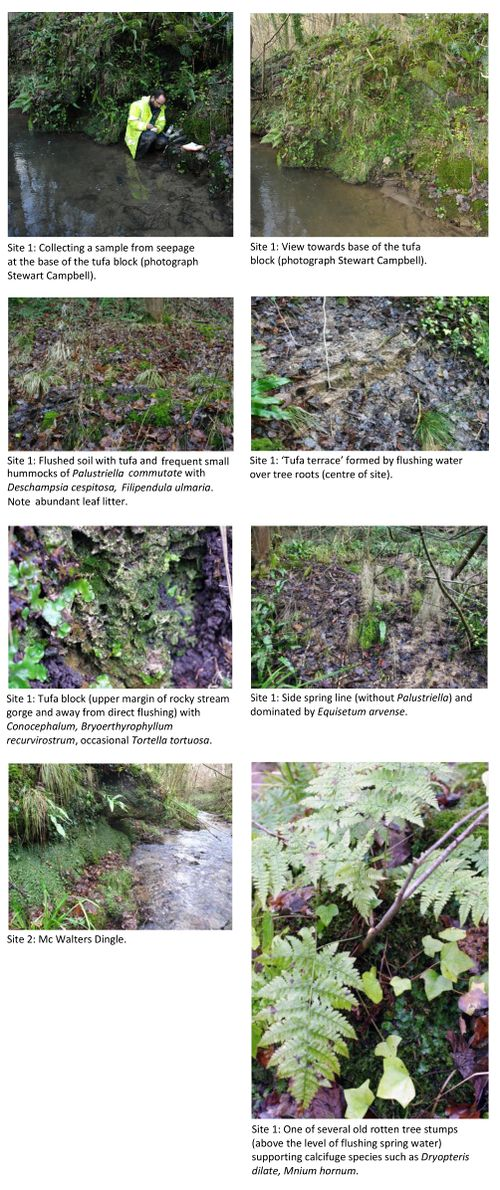
References
- ↑ HOWARD, A S, HOUGH, E, CROFTS, R G, REEVES, H J, and EVANS, D J. 2007. Geology of the Liverpool district — a brief explanation of the geological map. Sheet Explanation of the British Geological Survey 1:50 000 Sheet 96 Liverpool.